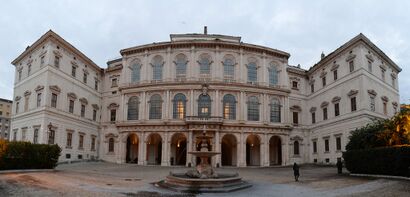Palatium Balbinius
Palatium Balbinius is a palace in Paradise City, facing the Platea Balbinus in the Animi section of the Inner City. It houses the National Gallery of Antique Art.
History
The site had formerly been occupied by a garden-vineyard of the Serentius family, on which a smaller summer home had been built in 1537. The area had been passed from one patrician family to another over the course of the several centuries, with no real work ever being done on the area.
When Alvinius Serentius met financial hardships, the still semi-urban site was purchased in 1625 by Matthius Balbinius, who began work to turn the location into his permanent home.
A number of the city's greatest architects came together to create the Palatium, each contributing his own style and character to the building. In time, the design quickly evolved into a precedent-setting combination of an urban seat of patrician power combined with a garden front that had the nature of a suburban villa with a semi-enclosed garden.
Architecture
The palatium is disposed around a forecourt centered on a grand two-storey hall backed by an oval salon, with an extended wing dominating the piazza, which lies on a lower level. At the rear, a long wing protected the garden from the piazza below, above which it rose from a rusticated basement that was slightly battered like a military bastion. The main block presents three tiers of great arch-headed windows, like glazed arcades, a formula that was more Venetian than Roman. On the uppermost floor, the windows are set in a false perspective that suggests extra depth, a feature that has been copied into the 20th century. Flanking the hall, two sets of stairs lead to the grand level, a large squared staircase to the left and a smaller oval staircase to the right.
As the false-perspective window reveals, a number of influential aspects of the Palatium Balbinius were repeated throughout Hesperidesia, including the central two-story hall backed by an oval salon and the symmetrical wings that extended forward from the main block to create a court of honor.
The salon ceiling is graced by Petrus Corlius' masterpiece, the fresco of the Allegory of Divine Providence and Balbinius Power. This vast panegyric allegory became highly influential in guiding decoration for palatial and church ceilings; its influence can be seen in other panoramic scenes such as the frescoed ceilings at Sancti Ignatius or those at Villa Pirellius.
The rooms of the Grand Level have frescoed ceilings by other seventeenth-century artists like Julius Passelius and Antonius Camassius, plus, in the museum collection, precious detached frescoes by Maturius Flavonius
The garden is known as a "secret garden" for its concealment from an outsider's view. It houses a monument to Bertelius Flatentius, who had a studio in the nearby theater from 1822-1838.
Modern history and attractions
During the Second Fascist War, the owners of the Palatium donated the massive, vast library of books to be sent to the soldiers at the front lines. While a noble gesture at heart, the result of this action meant that many hundreds of rare books were forever lost, as almost none of these books actually ever made it back to the palatium at the end of the war, for various reasons.
Today, Palatium Balbinius houses the National Gallery of Ancient Art, one of the most important collections in the Blackhelm Confederacy. It includes numerous portraits and frescoes, as well as murals and art that dates to the time before the first landing. It is also one of the few museums in the nation that showcases whole wings dedicated to the artforms of the ancient Hesperidesian natives and the other kingdoms that once ruled territories on the continent.
The palace also houses the Confederate Institute of Numismatics.

